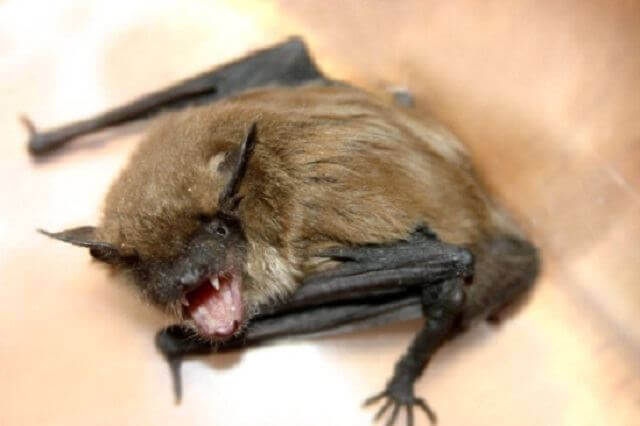Bat Facts & Information
Everything you need to know about bats
WHAT DO bats LOOK LIKE

A bat’s body is covered completely with hair, and they tend to have rather large ears. Bats use their ears to help them detect the location of objects around them or to locate insects flying through the air. Depending on the species, an adult bat can weigh less than 1 oz. and up to 3 lbs. Bats have two wings, consisting of a double membrane stretched across their elongated fingers and arm bones, which are their primary way of getting around. They have four limbs, two legs and two arms with the same bones as human hands modified as part of their wings.
Another interesting bat fact is they are the only mammal capable of true flight. The surface of a bat’s wing is equipped with bumps called “Merkel cells.” These bumps have tiny hairs that help sense airflow during flight so the bat can make adjustments for maximum flight efficiency.
Another interesting bat fact is they are the only mammal capable of true flight. The surface of a bat’s wing is equipped with bumps called “Merkel cells.” These bumps have tiny hairs that help sense airflow during flight so the bat can make adjustments for maximum flight efficiency.
Where do bats live
Bats are nocturnal, flying animals that are known for inhabiting dark and secluded locations. Since the discovery of the first bat fossil dating back 53 million years ago, scientists have identified over 980 species of bats worldwide, 40 of them living in the United States. Depending on the species, bats can live for up to 30 years. Most bats leave their roosts at dusk and return around dawn. When traveling, they first stop at a stream or pond for a drink of water before feeding. Female bats of most species tend to only reproduce one pup, but some species can give birth to two to four pups. At birth, a baby bat weighs up to 25 percent of its mother’s weight. While young bats are taken care of by females in the colony, male bats do not contribute to the caring of the babies.
Bats are a very important part of the pollination process, as they feed on insects that visit flowers and also feed on various types of fruit that helps disperse seeds. Since many bats do feed on insects, they can help keep pest insect populations down. One bat can catch up to 600 mosquitoes in an hour. We should probably be thanking them for that.
Bats are a very important part of the pollination process, as they feed on insects that visit flowers and also feed on various types of fruit that helps disperse seeds. Since many bats do feed on insects, they can help keep pest insect populations down. One bat can catch up to 600 mosquitoes in an hour. We should probably be thanking them for that.
How did I get bats
As with any other wild animal or household pest they choose to cohabitate with humans for three reasons: Harborage, food, and water. If they have chosen your attic or outbuilding as a roosting spot it’s likely because they have discovered your home or property is a fertile food source. Generally, bats enter a home or business by accident through an open door or window, or because they are dwelling in other parts of a home and make their way into living spaces.
What Problems do bats cause
Bats, in fact, will bite if they feel threatened or if handled improperly. A common misconception is that bats will attack humans for no reason, a myth that has been proven inaccurate. Most bat species feed on insects like moths and beetles. If you or someone you know has been bitten by a bat, it is important to seek medical care immediately to test for rabies transmission. Be sure to wash the bite and any other locations that have come in contact with the bat’s saliva.
A big concern most homeowners and business owners in New York, New Jersey, Connecticut, Delaware, and Pennsylvania have is whether or not the bats infesting their home have rabies. Unfortunately, it is impossible to tell if the bats have rabies solely based on appearance, so testing must be conducted. If transferred, rabies is a deadly disease that causes inflammation of the brain and sometimes death. However, bats are rarely rabid, with only less than 10 percent documented. In addition, if an infestation develops, it is important to treat the area for bat mites and bat bugs, which will bite humans.
In addition to the threat of rabies, the fungi that harbor in bat droppings can cause a lung disease known as histoplasmosis. An accumulation of droppings should be professionally decontaminated and removed – using a household vacuum is not recommended since it can spread it into the air. Aside from affecting human health, bat droppings can also damage the home. One bat can produce between 20-30 droppings a day. Because bats typically colonize in large groups, the number of droppings in a home can easily pile up and cause roofs to cave in. Their waste also attracts other pests like cockroaches, and the smell of their feces encourages other bats to invade the building.
A big concern most homeowners and business owners in New York, New Jersey, Connecticut, Delaware, and Pennsylvania have is whether or not the bats infesting their home have rabies. Unfortunately, it is impossible to tell if the bats have rabies solely based on appearance, so testing must be conducted. If transferred, rabies is a deadly disease that causes inflammation of the brain and sometimes death. However, bats are rarely rabid, with only less than 10 percent documented. In addition, if an infestation develops, it is important to treat the area for bat mites and bat bugs, which will bite humans.
In addition to the threat of rabies, the fungi that harbor in bat droppings can cause a lung disease known as histoplasmosis. An accumulation of droppings should be professionally decontaminated and removed – using a household vacuum is not recommended since it can spread it into the air. Aside from affecting human health, bat droppings can also damage the home. One bat can produce between 20-30 droppings a day. Because bats typically colonize in large groups, the number of droppings in a home can easily pile up and cause roofs to cave in. Their waste also attracts other pests like cockroaches, and the smell of their feces encourages other bats to invade the building.
How can I prevent bats
Bat-proofing a structure is the best way to prevent an infestation and the best time to bat-proof is after bats have left for their hibernation periods in the autumn. Attempting to bat-proof at any other time raises the possibility of boxing in babies who will then look for other parts of the house to escape to. At dusk, homeowners should inspect the exterior of the home and observe where bats enter and exit. Common access points include attic louvers and under facia boards. It is recommended that you have a professional seal any cracks or crevices with caulk and steel wool. Pay special attention to holes in the structure that lead to dark secluded areas, like attics and belfries. Also, screen attic vents and openings to chimneys, and install door sweeps.
Exclusion is the only method to keep bats out long term. You should contact a licensed pest professional if an active bat infestation is suspected, as the problem often cannot be controlled with do-it-yourself measures. Many states also have laws protecting bat species and removal may require a special license or approval.
Exclusion is the only method to keep bats out long term. You should contact a licensed pest professional if an active bat infestation is suspected, as the problem often cannot be controlled with do-it-yourself measures. Many states also have laws protecting bat species and removal may require a special license or approval.
why western for bat removal
We’re passionate about removing bats from your home or business because we live and work here – it’s our neighborhood, too. With our almost 100 years of experience keeping homes and businesses in Connecticut, Delaware, New Jersey, New York, and Pennsylvania safe from pests, Western has the experience you can trust.
100% Satisfaction Guarantee
24-Hour Guaranteed Response
Board Certified Entomologists
Consider bats escorted out.
GET A QUOTE
“We installed your Termite Defensive a number of years ago and have not seen even one termite since the system was installed.”
Edison, NJ
